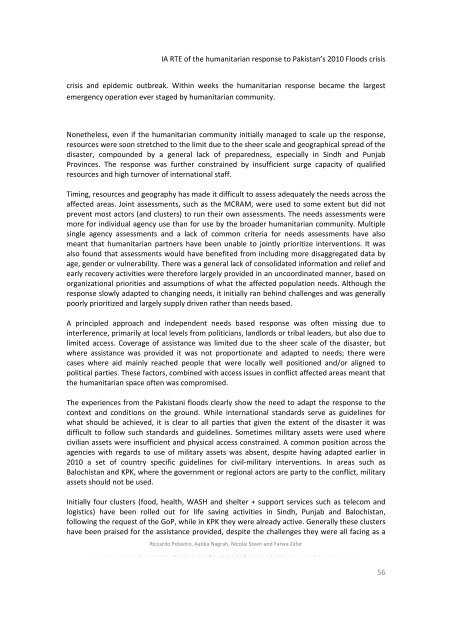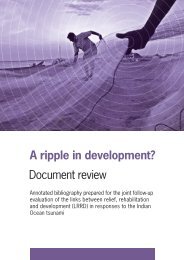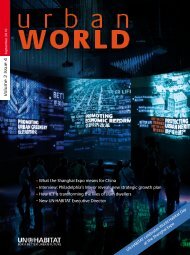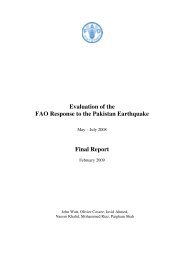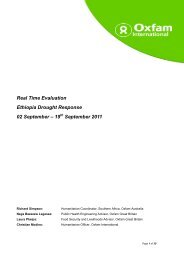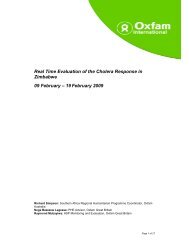Inter-Agency Real Time Evaluation of the Humanitarian ... - alnap
Inter-Agency Real Time Evaluation of the Humanitarian ... - alnap
Inter-Agency Real Time Evaluation of the Humanitarian ... - alnap
You also want an ePaper? Increase the reach of your titles
YUMPU automatically turns print PDFs into web optimized ePapers that Google loves.
IA RTE <strong>of</strong> <strong>the</strong> humanitarian response to Pakistan’s 2010 Floods crisis<br />
crisis and epidemic outbreak. Within weeks <strong>the</strong> humanitarian response became <strong>the</strong> largest<br />
emergency operation ever staged by humanitarian community.<br />
None<strong>the</strong>less, even if <strong>the</strong> humanitarian community initially managed to scale up <strong>the</strong> response,<br />
resources were soon stretched to <strong>the</strong> limit due to <strong>the</strong> sheer scale and geographical spread <strong>of</strong> <strong>the</strong><br />
disaster, compounded by a general lack <strong>of</strong> preparedness, especially in Sindh and Punjab<br />
Provinces. The response was fur<strong>the</strong>r constrained by insufficient surge capacity <strong>of</strong> qualified<br />
resources and high turnover <strong>of</strong> international staff.<br />
Timing, resources and geography has made it difficult to assess adequately <strong>the</strong> needs across <strong>the</strong><br />
affected areas. Joint assessments, such as <strong>the</strong> MCRAM, were used to some extent but did not<br />
prevent most actors (and clusters) to run <strong>the</strong>ir own assessments. The needs assessments were<br />
more for individual agency use than for use by <strong>the</strong> broader humanitarian community. Multiple<br />
single agency assessments and a lack <strong>of</strong> common criteria for needs assessments have also<br />
meant that humanitarian partners have been unable to jointly prioritize interventions. It was<br />
also found that assessments would have benefited from including more disaggregated data by<br />
age, gender or vulnerability. There was a general lack <strong>of</strong> consolidated information and relief and<br />
early recovery activities were <strong>the</strong>refore largely provided in an uncoordinated manner, based on<br />
organizational priorities and assumptions <strong>of</strong> what <strong>the</strong> affected population needs. Although <strong>the</strong><br />
response slowly adapted to changing needs, it initially ran behind challenges and was generally<br />
poorly prioritized and largely supply driven ra<strong>the</strong>r than needs based.<br />
A principled approach and independent needs based response was <strong>of</strong>ten missing due to<br />
interference, primarily at local levels from politicians, landlords or tribal leaders, but also due to<br />
limited access. Coverage <strong>of</strong> assistance was limited due to <strong>the</strong> sheer scale <strong>of</strong> <strong>the</strong> disaster, but<br />
where assistance was provided it was not proportionate and adapted to needs; <strong>the</strong>re were<br />
cases where aid mainly reached people that were locally well positioned and/or aligned to<br />
political parties. These factors, combined with access issues in conflict affected areas meant that<br />
<strong>the</strong> humanitarian space <strong>of</strong>ten was compromised.<br />
The experiences from <strong>the</strong> Pakistani floods clearly show <strong>the</strong> need to adapt <strong>the</strong> response to <strong>the</strong><br />
context and conditions on <strong>the</strong> ground. While international standards serve as guidelines for<br />
what should be achieved, it is clear to all parties that given <strong>the</strong> extent <strong>of</strong> <strong>the</strong> disaster it was<br />
difficult to follow such standards and guidelines. Sometimes military assets were used where<br />
civilian assets were insufficient and physical access constrained. A common position across <strong>the</strong><br />
agencies with regards to use <strong>of</strong> military assets was absent, despite having adapted earlier in<br />
2010 a set <strong>of</strong> country specific guidelines for civil‐military interventions. In areas such as<br />
Balochistan and KPK, where <strong>the</strong> government or regional actors are party to <strong>the</strong> conflict, military<br />
assets should not be used.<br />
Initially four clusters (food, health, WASH and shelter + support services such as telecom and<br />
logistics) have been rolled out for life saving activities in Sindh, Punjab and Balochistan,<br />
following <strong>the</strong> request <strong>of</strong> <strong>the</strong> GoP, while in KPK <strong>the</strong>y were already active. Generally <strong>the</strong>se clusters<br />
have been praised for <strong>the</strong> assistance provided, despite <strong>the</strong> challenges <strong>the</strong>y were all facing as a<br />
Riccardo Polastro, Aatika Nagrah, Nicolai Steen and Farwa Zafar<br />
56


